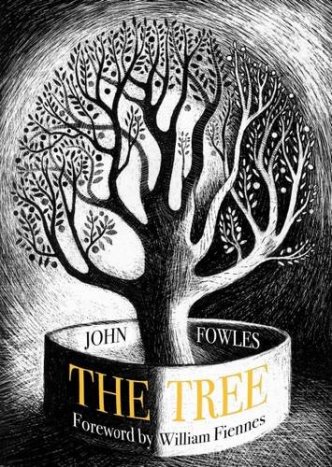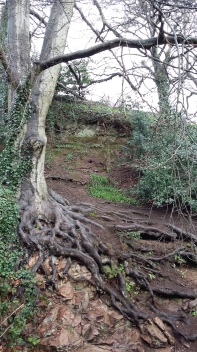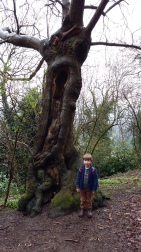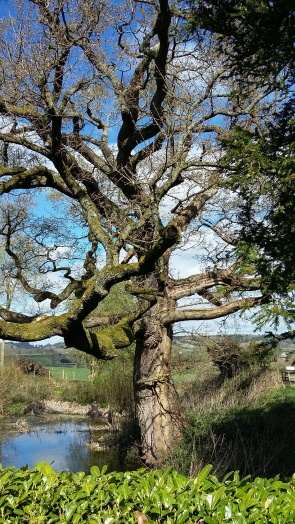Book Review: John Fowles, The Tree (Little, Toller 2016)
 John Fowles’ book The Tree is unlike any other book on trees I’ve read (and I’ve read quite a few recently). It is also a very beautiful book, with beautiful illustrations throughout by Ed Kluz, and an insightful foreword by William Fiennes. There is little scientific jargon here, attempts to describe trees are hedged with awareness of the limitations of language, and really, trees are just a starting point for what is really a long essay on human nature, society, art, and many other things. Trees, Fowles implies, can tell us everything we need to know – and nothing. That is why they are worth paying attention to. The book opens with the well-tended, domestic trees of Fowles’ father’s orchard, and moves through many wonderful digressions to conclude with the otherness and wildness of Wistman’s Wood:
John Fowles’ book The Tree is unlike any other book on trees I’ve read (and I’ve read quite a few recently). It is also a very beautiful book, with beautiful illustrations throughout by Ed Kluz, and an insightful foreword by William Fiennes. There is little scientific jargon here, attempts to describe trees are hedged with awareness of the limitations of language, and really, trees are just a starting point for what is really a long essay on human nature, society, art, and many other things. Trees, Fowles implies, can tell us everything we need to know – and nothing. That is why they are worth paying attention to. The book opens with the well-tended, domestic trees of Fowles’ father’s orchard, and moves through many wonderful digressions to conclude with the otherness and wildness of Wistman’s Wood:
fairy-like… teeming, jewel-like, self-involved, rich in secrets just below the threshold of our adult human senses. … all words miss, I know I cannot describe it.
Fowles makes some fairly contentious statements along the way, but the more I turn them over in my mind, the more sense they seem to make. He discusses how the Linnaean system of classifying organisms may have damaged our relationship with nature: the desire to own something, tame it and control it by naming, has deadened us to the thrill of not-knowing, the just-being.
These question-boundaries (where do I file that?) are ours, not of reality. We are led to them, caged by them not only culturally and intellectually, but quite physically, by the restlessness of our eyes and their limited field and acuity of vision.
 He describes later in the book the finding of a coveted plant specimen, and realising that he has measured and noted and photographed it, but was so much the collector that he couldn’t really see it. There is a smug pleasure in identifying every tree on a stroll, of course, but Fowles has made me wonder whether we should think less about facts, and more about our relationship with trees. How we respond to nature tells us more about ourselves, then, than it does about nature: all the research in the world won’t change the oak, but your silent contemplation of the tree might just change you. There is a mystery in nature which is, Fowles suggests, particularly significant in trees:
He describes later in the book the finding of a coveted plant specimen, and realising that he has measured and noted and photographed it, but was so much the collector that he couldn’t really see it. There is a smug pleasure in identifying every tree on a stroll, of course, but Fowles has made me wonder whether we should think less about facts, and more about our relationship with trees. How we respond to nature tells us more about ourselves, then, than it does about nature: all the research in the world won’t change the oak, but your silent contemplation of the tree might just change you. There is a mystery in nature which is, Fowles suggests, particularly significant in trees:
I cherish trees because of their natural correspondence with the greener, more mysterious processes of mind – and because they seem to me the best, most revealing messengers to us from all nature, the nearest to its heart.
Likewise, he strongly states that to look for measurable benefits in our relationship with nature is to misunderstand the world around us. It has become ingrained in our society to look for measurable, tangible benefits in everything: what is the financial value of the bumblebee? What is the social significance of dandelions? Such approaches are  becoming necessary as we try to find ways to protect our natural world, but the monetised, jargonistic language used is off-putting. For example, there is no doubt in my mind that trees are good for us, and that time spent in their company has many health benefits, both physical and emotional. Recent research supports this, indicating that mental health can be improved by time spent outside. An article entitled ‘What is the Best Dose of Nature and Green Exercise for Improving Mental Health? A Multi-Study Analysis’ in Environmental Science & Technology (2010) argues that:
becoming necessary as we try to find ways to protect our natural world, but the monetised, jargonistic language used is off-putting. For example, there is no doubt in my mind that trees are good for us, and that time spent in their company has many health benefits, both physical and emotional. Recent research supports this, indicating that mental health can be improved by time spent outside. An article entitled ‘What is the Best Dose of Nature and Green Exercise for Improving Mental Health? A Multi-Study Analysis’ in Environmental Science & Technology (2010) argues that:
Ecosystems provide important services driven by provisioning, regulation, and support functions. It is clear they also provide a health service arising from direct activities in contact with nature. Recognition of the potential contribution of natural ecosystems to human population health may contribute to addressing problems associated with inactivity, obesity, mental ill-health, and other chronic diseases.
Evidence shows that exposure to natural places can lead to positive mental health outcomes, whether a view of nature from a window, being within natural places, or exercising in these environments.
I don’t disagree, exactly, but I find the language of this and many other similar articles anachronistic. Of course, the authors are using the language of those who need to be convinced of the benefits, because if nature isn’t worthwhile to humans, it risks being eradicated (as if we could!) Fowles is well aware of the inability of language – even in the hands of a novelist like himself – to truly describe encounters with nature, but it is the language of utility which seems to destroy something:
To see woods and forests merely scientifically, economically, topographically or aesthetically, not to understand that their greatest utility lies not in the facts derivable from them, or in their timber and fruit, or their landscape charm, or their utility as subject matter for the artist, all this proves the gathering speed with which we are retreating into outer space from all other life on this planet.
 Nature is not there for our benefit, nor us for nature: it is a matter of peacefully co-existing and for humans, as sentient beings, to learn from trees – and they have wisdom to impart, as Fowles suggests. What we should do is retreat to the forest, the ‘green chaos’, not in expectation of any personal gain, but for the sake of the trees themselves, and this is something we can only experience individually. Fowles concludes:
Nature is not there for our benefit, nor us for nature: it is a matter of peacefully co-existing and for humans, as sentient beings, to learn from trees – and they have wisdom to impart, as Fowles suggests. What we should do is retreat to the forest, the ‘green chaos’, not in expectation of any personal gain, but for the sake of the trees themselves, and this is something we can only experience individually. Fowles concludes:
It, this namelessness, is beyond our science and our arts because its secret is being, not saying. Its greatest value to us is that it cannot be reproduced, that this being can be apprehended only by other present being, only by the living senses and consciousness. All experience of it through surrogate and replica, through selected image, gardened world, through other eyes and minds, betrays or banishes its reality.
Collecting tree stories for the Tree Charter, I’ve seen so many people’s stories of what  trees mean to them, and few of them are about classifying, or explicitly about what they ‘expect’ from trees. Rather, people write in their own way about how the beauty of a tree moves them, how trees console them in grief, or entertained them in childhood. Language may be imperfect for describing trees – we have no real arboreal terms of reference – but the experiences mediated through people’s own words are moving and genuine. And we do have a duty to protect trees, I think, from those whose sights are set more on profit than on wilderness, so please consider reading the Tree Charter Principles and signing the Charter.
trees mean to them, and few of them are about classifying, or explicitly about what they ‘expect’ from trees. Rather, people write in their own way about how the beauty of a tree moves them, how trees console them in grief, or entertained them in childhood. Language may be imperfect for describing trees – we have no real arboreal terms of reference – but the experiences mediated through people’s own words are moving and genuine. And we do have a duty to protect trees, I think, from those whose sights are set more on profit than on wilderness, so please consider reading the Tree Charter Principles and signing the Charter.
The Wind & Trees by John Clare
I love the song of tree and wind
How beautiful they sing
The licken on the beach tree rind
E’en beats the flowers of spring
From the southwest sugh sugh it comes
Then whizes round in pleasant hums
It sings the spirit of the storm
The trees with dancing waxes warm
They dance and bow, and dance again
The very trunks, each branch and grain
Shake and dance and wave and bow
In every form no matter how
In every storm they dance on high
The semblance of a stormy sky
Then sob and roar and bend and swee
The semblance of a stormy sea
I love the song of wood and wind
The sobs before its roar behind
I love the stir of flood and tree
‘Tis all of natures melody
I love the roaring of the wind
The calm that follows cheers the mind
‘Tis like the good mans end of peace
When joys begin and troubles cease



Leave a comment